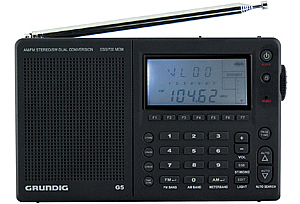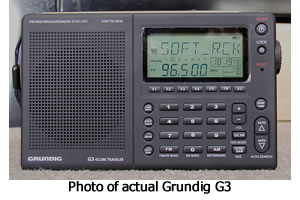 Grundig G5 / G3 comparison |
 |
Grundig G5 and G3
 As I've mentioned previously, I'm a big fan of Eton / Grundig. They continually introduce new models with upgrades and new features. The YB-400 is considered a classic and its replacement, the G5, brought performance to the next level; impressing many portable radio enthusiasts. But the gold standard (on the web at least) always seems to be the Sony IFC-SW7600GR. It has always ranked first in Passport and its legion of fans continually rank it high on various review sites. The major reason for this has been due to two features; synchronous detection and LSB / USB capability on SSB tuning.
As I've mentioned previously, I'm a big fan of Eton / Grundig. They continually introduce new models with upgrades and new features. The YB-400 is considered a classic and its replacement, the G5, brought performance to the next level; impressing many portable radio enthusiasts. But the gold standard (on the web at least) always seems to be the Sony IFC-SW7600GR. It has always ranked first in Passport and its legion of fans continually rank it high on various review sites. The major reason for this has been due to two features; synchronous detection and LSB / USB capability on SSB tuning.
When introduced back in 2006, the G5 was heralded for including a tuning knob (without chuffing) and superb filtering, especially on the FM band. Its other features like memories and alarm functions outweigh both Sony and Sangean's top portable offerings. Many agree most Grundig models have superb audio properties from the on board speaker. (Although older males suffering from high frequency hearing loss always complain that Grundig is too muddy.) More on this important detail later.
My guess is that the design team in Palo Alto decided to go for the gold and create the radio that would finally squash the SW7600GR and finally claim that elusive top honor. So not only did Eton add synchronous detection and the LSB/USB switch found in the Sony, it incorporated RDS for FM (Sangean ATS-909) and Air band (introduced in the G6). While the G5 rated four stars in Passport and the SW7600GR garners four and one-third stars, could the G3 attain four and a half, possibly four and three-quarter stars?
Unfortunately, fate and a rush to get the G3 into the market proved unkind. First, the bible of SW radio reviews, Passport to World Band, announced it would cease publication the month of the G3's release. Then the initial run of G3's suffered from quality control, so early reviews on Amazon, eHam, Herculodge and Radio Intel were less than favorable. With high expectations coming off the heals of the surprising G6 Aviator and the solid reputation of it's older sibling, the G3 came out of the gate limping.
 Despite having no interest in the upgrade, I still read with interest most articles and reviews of the G3 and wanted to get my hands on one to compare everyone's findings. Sure enough, a friend let me use his for a few weeks.
Despite having no interest in the upgrade, I still read with interest most articles and reviews of the G3 and wanted to get my hands on one to compare everyone's findings. Sure enough, a friend let me use his for a few weeks.
One of the first things I confirmed is that the radio that comes out of the box does not look like the radio on the box (or Eton's web site!). Yes, it's essentially the same shell as the G5, but the dial is very different. Why didn't anyone take the time to photograph the new radio?
First, I tuned to the FM dial and my excitement started to build. Having RDS display on the dial was cool and the sound was somewhat fuller than the G5. The G5 sounds great, but it leans a little more towards mid-range than I like. The new G3 has a bright high end and definitely fuller bass. Although it took a moment to get used to capturing stations only dead-on their frequency, the G3 has better filtering on FM than any radio I've ever used. I received a Class A FM 35 miles away on 95.9 between two strong signals at 96.1 and 95.7 without and bleed. Supposedly, the G8 ($50 / Universal) features the same filtering.
Over to MW/SW and my excitement faded fast. The sound on the local AM was on par with the Mini-300. I switched to Synchronous Detection and it improved somewhat, but the audio was very thin. (This is my first experience with SD and I'm not sure I'm qualified to analyze its properties.) Personally, I'd rather listen to a full, pleasant sound with occasional fading than tonal qualities akin to a phone. The band is quieter than the G5, but with this unit, it was not as sensitive.
I should explain here that I do DX to a point; if a station is "barely audible," I'm not very interested in listening for a long period. I'll catch the ID, then move on. If that was my primary goal, I'd buy a ICOM IC-R75-12 and hang a long wire into the woods behind my house. After listening to MW and SW on this unit for a few weeks, I have to assume that Eton may have been paying too much attention to all those males suffering from high-end hearing loss.
Little things also make a difference in getting the radio crowd behind a new product. The G5 was a re-worked Degen 1103. (The 1103 is a phenomenal radio, plagued by hostile ergonomics.) The G5 added more buttons, a volume control, lighted buttons and a slew of "user-friendly" improvements. Buyers didn't care that the signal meter didn't work on FM, this was a radio to own. Despite the fact that the G3's dial is arranged better and easier to read at various angles, the buttons no longer illuminate and this negative aspect is getting the attention. Yes, the signal meter now works on FM, but the tone control was eliminated. (Some of the dial/function characteristics were brought over from the G6. The volume steps are smaller and the buttons don't illuminate on that model either.)
For now I'm staying with the G5 (and G6), as I'm sure there are stalwarts holding onto their YB-400PE. There are some who feel the best radio Grundig ever built was the Satellit 700. (Too bad Eton scrapped plans to flip the E1 to the G1000. It looked beautiful in the ads that ran in Passport 2008. BTW, Passport 2009 is still on sale and may be a collector's item someday.)
I sold the G3 on eBay and the buyer was very happy. From subscribing to Grundig groups and Jay Allen's new review on Radio Intel, it looks the the later run of the G3 is gaining respect and momentum, especially among the DXing short wave and ham fanatics. In conclusion, that's the beauty of the Grundig line; there's a radio crafted for different needs and preferences. And that is always a good thing. Can't wait to see what's next. :)
photo of Grundig G3 courtesy of colbalt pet shortwave
back
to the top
back to radio home page
back to radio reviews
return to my radio career
back
to jack jr. home page.
back to kratoville.com